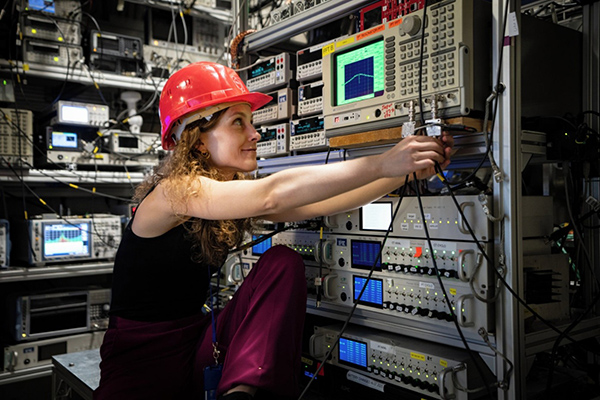Publication in the scientific journal “Nature”: Milestone in antimatter research

The BASE collaboration at the European Organization for Nuclear Research CERN in Geneva has achieved a breakthrough in antimatter research: For the first time, the researchers were able to let a single antiproton – the antimatter counterpart of a proton – oscillate between two quantum spin states in a controlled manner for almost a minute. The collaboration includes scientists from numerous international institutions, including researchers from Heinrich Heine University Düsseldorf (HHU) and AVA partner GSI/FAIR. The study, which has now been published in the journal Nature, marks the world’s first realization of an antimatter quantum bit (qubit for short). “This is a milestone that will enable much more precise tests of fundamental symmetries in the future,” says HHU physics professor and BASE spokesperson Stefan Ulmer.
Compared to a proton, antiprotons have the same mass but the opposite electrical charge. Both particles behave like miniature rod magnets. Their so-called spin – comparable to a compass needle – points in one of two directions. The precise measurement of the associated magnetic moment, in particular a controlled “flipping” of the spin, is one of the central tools of modern quantum measurements. It enables high precision tests of fundamental laws of nature.
The study used the method of “coherent spin quantum transition spectroscopy”. This enables the high-precision manipulation and observation of individual spin states. The measurements are motivated by tests of the so-called CPT symmetry (charge, parity, time reversal) which requires that matter and antimatter – apart from their opposite charges – behave in exactly the same way. As a consequence, they should also appear with the same quantity in our universe. However, the real world shows a considerable asymmetry: it consists almost entirely of matter. This is still an unsolved mystery of modern physics.

The multi-penning trap system in which the coherent spin quantum transitions were determined with a single trapped antiproton. The trap stack consists of (from left) a reservoir trap, a parking trap, a shielded precision trap, the actual analysis trap and a cold trap. The trap electrodes marked in gold are separated from each other by sapphire rings (blue). Image credit GSI/FAIR.
So far, such coherent quantum transitions have been observed, for example, in macroscopic particle ensembles or in the hyperfine structure of stored ions. The BASE collaboration has now for the first time demonstrated and observed such coherent flips of a single free nuclear spin of an antiproton – which is an enormous physical and technical challenge.
“A good analogy for this is a child’s playground swing,” explains Professor Ulmer. “With the right push, the swing arcs back and forth in a perfect rhythm. In our case, the swing is the spin of a single antiproton, which we set into motion in a controlled manner using electromagnetic fields. On top of that, we achieved a coherence time of 50 seconds.”
The antiprotons, required for the experiment, were produced by CERN’s Antimatter Factory (AMF) and stored in Penning traps - high-precision electromagnetic instruments for exact particle control. The antiprotons were then individually transferred to a separate multi-trap system in which their spin states could be measured and manipulated. “This is nothing else than a qubit based on a single antiproton spin,” emphasizes CERN scientist Dr. Barbara Maria Latacz, first author of the publication.
The BASE collaboration has previously been able to show that the magnitudes of the magnetic moments of protons and antiprotons are identical within a just few parts-per-billion. Dr. Christian Smorra from HHU explains "At that time, however, incoherent spectroscopic methods were used, in which magnetic field fluctuations and technical perturbations affected the spin dynamics. This ultimately limited the accuracy."
But is there still a tiny difference? An essential question, because even the slightest difference would break CPT symmetry and thus point to new physics beyond the Standard Model of particle physics
Substantial upgrades of the experimental setup have now made it possible to systematically suppress these decoherence mechanisms and enable the first coherent spectroscopy of an antiproton spin. The research team thus not only created a stable antimatter qubit, but also unlocked new measurement methods.
“This work gives us the opportunity to apply the entire spectrum of coherent spectroscopy methods to single particles of antimatter for the first time,” emphasizes Ulmer, adding: “Specifically, we expect to be able to determine the magnetic moment of the antiproton with ten times improved precision in the future, and in the long term with up to a hundred times greater accuracy, for example in dedicated laboratories that we are currently developing at HHU.”
The next big leap is already planned: Using the newly developed BASE-STEP system, antiprotons will in future be transferred with transportable traps from the AMF to highly-stable precision laboratories. There, significantly longer spin coherence times can be achieved and thus a much higher measurement accuracy.
“Once it is fully operational, our new offline precision Penning trap system, which will be supplied with antiprotons transported by BASE-STEP, could allow us to achieve spin coherence times maybe even ten times longer than in current experiments, which will be a game-changer for baryonic antimatter research,” says Barbara Latacz.
The publication in Nature can be found here
This article is based on an original article published on the GSI/FAIR website here